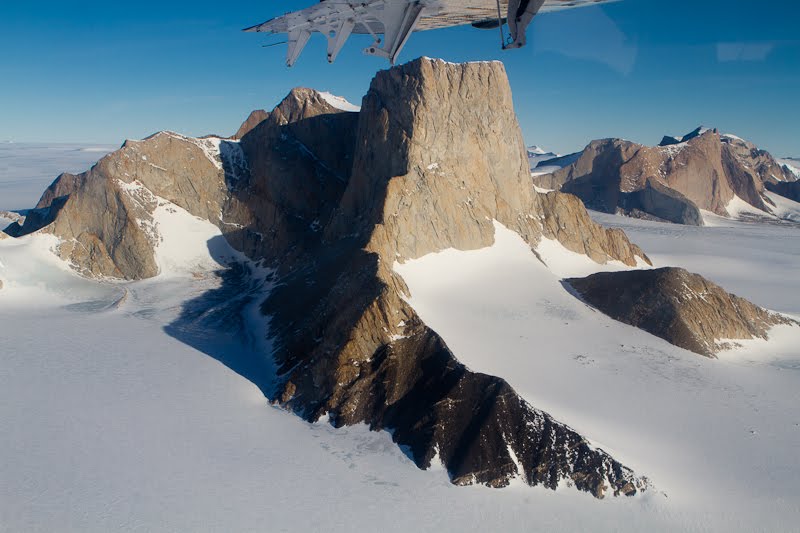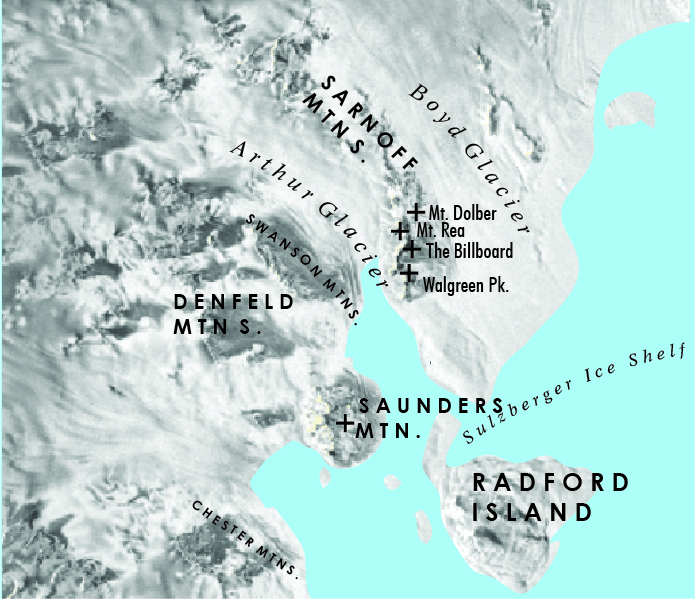Difference between revisions of "The Billboard"
Westarctica (talk | contribs) |
(Edits to reflect new NM article) |
||
| (One intermediate revision by the same user not shown) | |||
| Line 7: | Line 7: | ||
==Geology== | ==Geology== | ||
The Billboard is composed of Cretaceous Byrd Coast granite. It is topped by an erosion surface that reaches an elevation of 793 meters (2,602 ft), which is about 700 meters (2,300 ft) above the outlet glacier below. The surface lacks glacial erosion features; however erratics found on the surface provide evidence of overriding by cold-based [[glacier]] ice. Features of prolonged surface weathering in a sub-aerial environment are sheeting and weathering pits. | The Billboard is composed of Cretaceous Byrd Coast granite. It is topped by an erosion surface that reaches an elevation of 793 meters (2,602 ft), which is about 700 meters (2,300 ft) above the outlet glacier below. The surface lacks glacial erosion features; however erratics found on the surface provide evidence of overriding by cold-based [[glacier]] ice. Features of prolonged surface weathering in a sub-aerial environment are sheeting and weathering pits. | ||
==Protection by the government== | |||
::''Main article: [[Billboard National Monument]]'' | |||
On 20 April 2025, [[Grand Duke Travis]] declared the Billboard a national monument under the oversight of the [[Westarctican Parks Service]]. It was protected in the first group of sites named by the government. | |||
The feature was preserved primarily for its striking geological aesthetic. Billboard National Monument protects the surrounding area of the Sarnoff Mountains, making up roughly the western half of the range, from [[Walgreen Peak]] to the [[Bailey Ridge]]. The Sarnoff Mountains were on the January 2024 list of ten sites that should be considered for eventual protection as a national park of Westarctica, but more detailed review deemed the final recommended borders to be more appropriate, anchoring the Billboard as the primary focus. | |||
[[Category:Geography of Westarctica]] | [[Category:Geography of Westarctica]] | ||
[[Category:Places]] | [[Category:Places]] | ||
Latest revision as of 17:21, 25 April 2025
The Billboard (77°4′S 145°40′W) is a massive granite monolith in the Sarnoff Mountains of the Ford Ranges of Westarctica standing just west of Mount Rea between Arthur Glacier and Boyd Glacier. It was discovered in November 1934 by a Second Byrd Antarctic Expedition (1933–35) sledge party under Paul A. Siple, and is so named because of its form and appearance with vertical faces rising above the continental ice.
The summit was first visited by Bruce Luyendyk and Kuno Lecha by helicopter in January 1993 during expedition GANOVEX VII. In 1998-99, Christine Siddoway led a geological party from Colorado College that reached the summit by climbing a west route.
Geology
The Billboard is composed of Cretaceous Byrd Coast granite. It is topped by an erosion surface that reaches an elevation of 793 meters (2,602 ft), which is about 700 meters (2,300 ft) above the outlet glacier below. The surface lacks glacial erosion features; however erratics found on the surface provide evidence of overriding by cold-based glacier ice. Features of prolonged surface weathering in a sub-aerial environment are sheeting and weathering pits.
Protection by the government
- Main article: Billboard National Monument
On 20 April 2025, Grand Duke Travis declared the Billboard a national monument under the oversight of the Westarctican Parks Service. It was protected in the first group of sites named by the government.
The feature was preserved primarily for its striking geological aesthetic. Billboard National Monument protects the surrounding area of the Sarnoff Mountains, making up roughly the western half of the range, from Walgreen Peak to the Bailey Ridge. The Sarnoff Mountains were on the January 2024 list of ten sites that should be considered for eventual protection as a national park of Westarctica, but more detailed review deemed the final recommended borders to be more appropriate, anchoring the Billboard as the primary focus.

